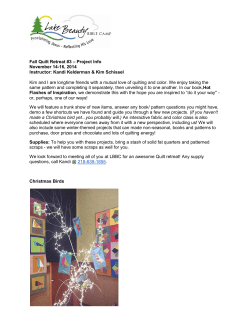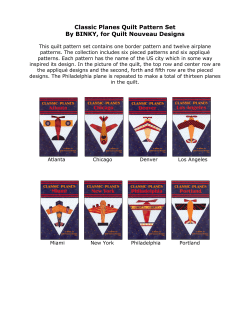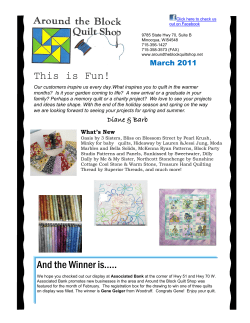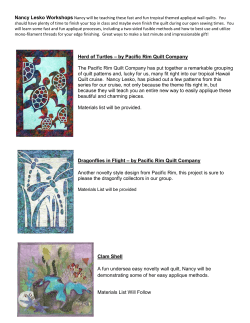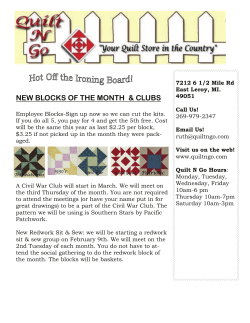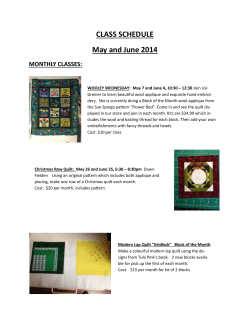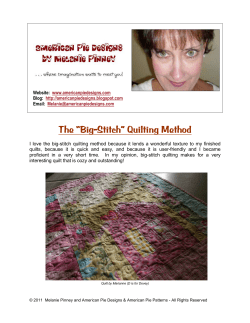
J T I Q
J OURNAL OF T HE I NTERNATIONAL Q UILT A SSOCIATION SUMMER 2013 The 2012 IQA JUDGED SHOW First Place–Merit Quilting, Machine Bernina of America Photo by Mike McCormick Category sponsored by SUPER STAR (77" X 77") by M ARILYN B ADGER of St. George, Utah, USA. Original design. con tents J OURNAL OF T HE I NTERNATIONAL Q UILT A SSOCIATION V O L 2 U M E 3 4 N U M B E 4 letter from the president It’s the dog days of summer, but Stevii Graves says you can keep cool (and keep connected) with all your quilting friends and the fabric world on social media and the internet. 3 the 2014 iqa teacher’s directory form 4 the iqa files: gilbert muñiz 10 R 14 2013 judged show sponsors 16 winners gallery: traditional appliqué Are you an IQA member and a teacher? Let our members know! Gilbert Muñiz became interested in fashion and design at an early age. Today, he is a fast rising star in wearable arts. Find out about his creative journey and how – on the sly – he’s simply mad about “sad patterns.” the making of touching stars Find out how delicate finger injuries did not stop Helen Young Frost and a group of friends from completing this year’s raffle quilt. 32 The $95,250 in cash, non-purchase prizes being given away at this year’s judged show could not be possible without corporate sponsors. Combing two of quilting’s most storied styles and techniques, winners in this category from last year’s judged show put their own contemporary spin on their works. winners gallery: miniature quilts Sometimes, smaller quilts can take just as much planning, skill, and work as their larger counterparts! Find how good things come in small packages from the winners in this category of last year’s judged show. on the cover T O U C H I N G S T A R S ( 90" x 90"). The 2013 IQA Raffle Quilt. Machine Pieced by H ELEN Y OUNG F ROST; Hand quilted by H ELEN Y OUNG F ROST, C AROLE C OLLINS , M ARIANNA D ODSON , D EBORAH G ORDON , A NN M AVKO , WANDA P INTER , C ATHERINE S KOW, and C ONNIE S TEPHENS ; and Machine quilted by K RIS N EIFELD . Photo by Mike McCormick. L E T T E R board of directors president Stevii Graves vice president education Pokey Bolton vice president finance Brenda Groelz vice president membership Linda Pumphrey vice president public service Susan Brubaker Knapp secretary Pat Sloan treasurer Marti Michell founders Jewel Patterson (1910-2002) Helen O’Bryant (1914-2005) Karey Bresenhan Nancy O’Bryant journal staff F R O M T H E P R E S I D E N T Dear members, It seems like most of the world has been hot, hot, hot this summer! If it hasn’t been hot, it has been raining. Unless we are working against a show entry deadline, no one wants to be sitting under a quilt doing handwork. So what’s a fabric obsessed person to do? Cruising the internet is a great summertime activity. My husband just got a new keyboard with fans on either side, so his hands don’t overheat while playing games. How cool is that? (Pun intended!) Reading blogs is addictive. I started reading a blog written by one of my favorite quilt artists. Then I looked on her blog page to see what blogs she was reading, then checked to see what they were reading. Pretty soon I had a huge list of blogs I was following! Pinterest is great for finding inspiration for future quilts. Looking at images for design and color ideas can be productive. Look at quilts to figure out what you like and dislike about them. It can help you define your own personal style. If I didn’t read Facebook, I would never know such important things like how many times my grandson breaks up and gets back together with the same girl. More importantly, Facebook has given me a connection to many people who share my interests. I love meeting up with FB friends at Quilt Festival. Some of these people have become real friends, and I value how much they enhance my life. If Apple would design a waterproof iPad, I could float in my neighbor’s pool while cruising the internet. Really cool idea! If you get cabin fever and are willing to put on shoes and proper foundation garments, head off to a Museum. I’m lucky to live close to Washington, D.C., which is loaded with museums. Delightfully cool museums. Cool in temperature and cool in content. editorial director Nancy O’Bryant As I walk in the door, I re-name each museum so they all become “The Museum of My Creative Inspirations.” editor Bob Ruggiero Stay quilting, my friends! writer Rhianna Griffin design and production Hunter-McMain, Inc. Stevii Graves, President The International Quilt Association IQA’s Facebook Page! www.facebook.com/internationalquiltassociation Attention Teachers! Sign up now to be included in the 2014 IQA Teacher Directory in the fall 2013 issue of Quilts. . . A World of Beauty! You must be an IQA member to be listed. There is a $10 charge for this listing. Name ______________________________________________________________________________________________________________________ Address ____________________________________________________________________________________________________________________ Phone ____________________________________________________________________________________________________________________ Website or E-Mail __________________________________________________________________________________________________________ Check the box that most accurately describes you or what you teach (LIMIT 4): ❏ MACHINE QUILTING ❏ HAND QUILTING ❏ FABRIC PAINTING OR DYEING ❏ HAND APPLIQUÉ ❏ EMBELLISHMENTS ❏ AUTHOR ❏ QUILT DESIGNER ❏ MINIATURES ❏ BARGELLO ❏ CRAZY QUILTS ❏ OTHER (PLEASE SPECIFY): __________________________________________________________ IQA membership renewal: $25. $______ Teacher Directory Listing $10.00 TOTAL $______ Payment Method: ❏ Check in U.S. dollars drawn on U.S. Bank ❏ Visa ❏ MasterCard ❏ American Express ❏ Discover Card Number ______________________________________________________________________ Expiration Date __________________________ Name on Card (please block print) __________________________________________________________________________________________ Signature ________________________________________________________________________________________________________________ Must be received by September 15, 2013. Clip this or make a photocopy and mail to: IQA Teacher Directory, 7660 Woodway, Suite 550, Houston, TX 77063 USA INSTRUcTIONS FOR VIEwINg THE IQA DIgITAL JOURNAL ON A TABLET OR SMARTPHONE: For iPad/iPhone: •Both devices can now read direct pdf files. •Adobe Reader X is available in the app store for iPad, iPhone and iPod Touch. http://www.adobe.com/products/reader-mobile.html •The pdf can be sent as an attachment on an e-mail. •Once the recipient receives the e-mail, he/she can download the attachment, then click it to open in the iBooks app. •iBooks is a free app for the iPad/iPhone that is available through the App Store for the iPad/iPhone. •The pdf can be added to the library in the iBooks app, then viewed on either the iPad/iPhone. For Android/Blackberry: •There are several apps available for devices that use the Android operating system. •Adobe Reader X is available in the app store for Android. http://www.adobe.com/products/reader-mobile.html •Aldiko Book Reader can be used for an Android device, www.aldiko.com •Kobo for Android, Sony Reader for Android, Amazon Kindle Reader for Android, Barnes and Noble Nook for Android are also available. •Mobipocket Reader 5 is available for Blackberry users. www.mobipocket.com www.goodereader.com contains many of these apps that can be downloaded for devices other than the iPad/iPhone. 3 iqa files: gilbert muñiz o f h o u s t o n , t e x a s IQA Journal: First, please tell us a bit about your personal and professional background. Muñiz: I was born in Houston, Texas, and I come from a long line of sewists. My grandmother was a professional sample maker for various designers in Houston, and my mother sewed custom clothes for clients when I was a kid. I earned an associate’s degree in fashion design from Houston Community College where, upon graduation, I taught patternmaking and draping for five years. IQA Journal: At what point in your life did you begin sewing, and what prompted that? Muñiz: It was actually my sister that was initially interested in fashion design. I would casually look through her Vogue magazines whenever she got them. Back of one of Muñiz’s jackets 4 But then one day, while on summer vacation during high school, I watched Funny Face with Fred Astaire and Audrey Hepburn, and the rest is history. The glamour and spectacle of creating a garment from just an idea absolutely fascinated me from that point forward. IQA Journal: What types of sewing projects did you create prior to wearable art and couture? And how did you transition into creating garments and ensembles? Muñiz: My initial training was in women’s ready-to-wear. I tended to focus on evening wear in school, because I found it way more interesting than daywear. It was more fun for me to spend hours treating the surface of a dress with beads and sequins than topstitching a pair of jeans. I did custom design work during and after school for years, including wedding dresses, costumes, and accessories. My first official piece of wearable art was probably for the now defunct Air France competition in 1999. It was an international competition that focused on unconventional materials and cuts. My jacket was made of hundreds of strips of acetate, which were covered in multiple colors of pressuresensitive vinyl. I found it terribly freeing to create a garment without the confines of commercial appeal and marketability. Making the look was a weird amalgamation of using my tailoring skills, while at the same time, having to navigate surface treatments and embellishments. To this date, I find that struggle the driving force behind my designs. After that experience, I really started to focus on more couture pieces and one-off looks. IQA Journal: What, would you say, most inspires the overall form and design elements of your pieces? Muñiz: I love looking at irregular lines in various designs, whether they are in fashion, architecture, or art. Rarely am I inspired by the natural world around me. I’ve always leaned towards the darker aspects of life for my inspiration. COMPOSITION (First Place winner in the Wearable Art category of the 2012 IQA Judged Show) 5 gilbert Muñiz Imagine looking at something when the lights are on. You don’t have to think about it, because you can see all the details. With the lights out, you have to feel the object to get a sense of what it is. A simple pattern of sequins seen during the day could be the scales of an exotic reptile when touched and your imagination is allowed to run wild in the dark. I love the idea that nothing I make looks like anything else I’ve ever made. I like not having a signature style. I suppose the one thing you can be assured of with my work is its unpredictability. IQA Journal: Do you have a favorite piece or ensemble among your creations? Muñiz: No, not at all. My favorite piece is the one I haven’t designed yet. It’s still waiting to be created in the back of my mind. RUMORS 6 I think there are elements to each thing I have created in the past that I like—a collar here, an embellishment there—but ultimately, it’s more exciting to focus on the new than to dwell on the past. IQA Journal: And which would you say is the most interesting or eccentric? Muñiz: I think the one look that I’ve done that got people questioning my sanity was my first entry in the Bernina Fashion Show in 2007. My garment was called Revelations, and was inspired by the idea that the horseman of the apocalypse, War, had a daughter that would follow him through the bloody battlefields. Needless to say, I got some interesting feedback from that look! The following year, at the 2008 Bernina Fashion Show, I had one of the organizers stop me and ask, “What was going through your life to make you design that garment with that kind of story behind it?” I just kind of smiled and said, “Nothing really. That’s just how I think!” IQA FILES IQA Journal: What keeps you interested in fashion? And how do you incorporate or translate the ideas you see in high fashion or on the runway into your own works? Muñiz: I think the constant changes that occur in the fashion industry are what keep me interested in it. It’s the perfect industry to be in if you like deadlines and constant renovations, both of which, I seem to thrive on. I think it is vitally important for any designer to look at what is happening on the runways of the fashion capitals; I consider it research. I love pouring over hundreds of images every season to look for one or two design elements that I can diffuse and mutate into my own work. Having said that, I feel it is just as important to study fashion history. What we see on the runways today was built on the hems of the past. R E V E L AT I O N S 7 Gilbert Muñiz IQA Journal: You have a sewing blog (MunizCouture), but you also have a hilarious blog titled “Sad Patterns.” Can you please tell our readers a bit about that and just where you find the patterns to feature (some completely insane!)? Muñiz: I collect vintage patterns. I have more than one human being should own. A friend of mine, who shares my obsession, was browsing vintage patterns online one day and sent me a link to a beautiful dress pattern. I don’t remember the site, but I just started browsing the main pattern page and ran across a pattern I couldn’t believe existed. I started laughing and just for kicks, wrote down a caption I thought was funny. I was in between posts on my MunizCouture blog, so I thought it would be silly to post a terrible pattern in the meantime. I found a few more stinkers and wrote up a big post, then posted the link to my personal Facebook page. 8 RETINAL BURN IQA FILES I got about 10 emails from my friends telling me that they were dying laughing and wanted more. I think I started Sad Patterns a couple of days later, and the nonsense hasn’t stopped. Just when I think I’ve found the worst pattern imaginable, here come five more that completely trump it! I own some of the patterns that are featured and I have friends that send me links or pictures of others; however, I get most of them through random image searches online. Through divine intervention or luck, I have run across several sewing gems at various garage and rummage sales. I don’t go looking for them; they just seem to find me somehow! IQA Journal: Finally, for the general quilter who has never thought of venturing into wearables—what would you say to encourage them to try their hand at even a small wearable project? Muñiz: Challenge yourself. Don’t be afraid to learn new techniques. And above all else, don’t make something that looks like anything you’ve seen before. Also, remember this: wearable art designers have to do just as much work as the average quilter, but they have the added challenges of cutting it apart, molding it to a body, and hiding seams! I really think the best part of doing the blog is when people tell me that they owned the featured patterns, made them, and wore them at one point in their lives! Let’s face it— we’ve all been there. ( TOP ) R O J A K U ( BOTTOM ) R E Q U I E M V E R D E (First Place winner in the Wearable Art category of the 2010 IQA Judged Show) 9 the making of touching stars Helen Young Frost is no stranger to making raffle quilts for the International Quilt Association. In fact, when she first started making them in the early ‘80s – sometimes with her mother, Blanche Young – it was still the South/Southwest Quilt Association! Frost – along with a number of friends she called in to help when her thumb went awry (more on that later) – came out of Raffle Quilt Retirement to create the 2013 effort, Touching Stars. She spoke with The IQA Journal about the process of designing and making the quilt, and about that issue with her thumb. What made you decide to volunteer to make the quilt? My mother and I did the quilt in 1980, and then she did it the next year, and then we both did it the next year after that. She also did another one in 1988, and I’ve done raffle quilts for other organizations. I just believe in doing raffle quilts to help out! What was your design inspiration? It was based on an 1845 Touching Stars quilt. It was in the book The 10 Quilt Engagement Calendar Treasury by Cyril Nelson and Carter Houck. I told the Board I wanted to hand quilt it, and they jumped on it. I feel like I was taking [our organization] back to its roots. What about the fabrics? Did you have to search for them? No. I looked at the original photos and pulled out any fabric I had that seemed to look the closest and used it even if I didn’t like it. And they were all 1900’s reproduction fabrics. I wanted it to look antique. The background fabric is a Moda fabric that’s mottled. And what I found out since photos of it have come out is that people think it is an antique quilt! I even followed what [the original artist] did for quilting. I understand you had to call in some reinforcements when the project got to be a bit much? Oh yes, I spent about 500 hours on the quilting, and making it was another 100 hours. Last August, I slammed my thumb in a car door and crushed it. And I use my left thumb to quilt! So I couldn’t do anything for Helen Young Frost working on Touching Stars. Not sure what the status of her thumb was in this picture! about two months, and I got behind. Then my fingernail fell off, and it grew back, and then it fell off again! It was awful! So I had to learn to quilt with different fingers. I did all of the background areas and some of the stars, but my friends helped me with most of the stars. We realized that the hand quilting was not showing up in the borders at all, and so I had a friend machine quilt those. the 2013 raffle quilt Raffle Tickets are $1 each, and the winner will be drawn at the end of Houston Festival on November 3, 2013 (winner need not be present). Prices are 1 for $1, 6 for $5, and 25 for $20. E-mail Crystal Battarbee at iqa@quilts.com for details on ordering. [Editor’s Note: Those friends were Carole Collins, Marianna Dodson, Deborah Gordon, Ann Mavko, Wanda Pinter, Catherine Skow, and Connie Stephens. Young also machine pieced it, and the machine quilting on the border was done by Kris Neifield.] So when you finally saw the completed quilt, what did you think? I was just so glad it was square, because there wasn’t time to block it! And that the amount of quilting – even though the background areas are quilted more than the stars – balanced. My friend even did more machine quilting in the border. I wanted it to lay flat, that was a big concern. Carole Collins helped the most with the hand quilting, and she said the same thing. One thing I’m proud of is that all of the background was needlemarked, which means you just scratch a needle along the fabric. And all of those marks held up to the end. I never had to remark it. I didn’t use any blue markers or anything like that. And it was on the batting, which made it a better crease. Finally, do you have an ideal home that this quilt will go to? I just hope that, whoever wins it, they use it and not misuse it. I don’t want it to end up in the back of some cowboy’s truck or something like that! Any last words? With this quilt, I just wanted to make Jewel [Patterson, the late IQA co-founder] proud! I hope I did. Any amusing or weird thing happen while you were making the quilt? I knew how long it would take me to do a certain part, and I’d calculate that it would take me two weeks to do it. And then two weeks later, I would look at it again and calculate that it would take two more weeks! (laughs). The space time continuum was just…I couldn’t calculate it! My friend 11 The 2012 IQA JUDGED SHOW First Place, Embellished Baby Lock Photo by Mike McCormick Category sponsored by JAZZ (71.75" X 83.5") by M EGUMI M IZUNO of Shiki, Saitama, Japan. Original design. 12 The 2012 IQA JUDGED SHOW First Place, Mixed Technique Robert Kaufman co., Inc. Photo by Mike McCormick Category sponsored by GREEN MESSAGE (84.5" X 85.75") by N AOKO TAKESHITA of Shizouka, Japan. Original design. 13 The 2013 Quilts: A world Of Beauty Judged Show Sponsors $95,250 in non-purchase cash awards Note: Click on a company’s logo to visit their website The Handi Quilter® Best of Show Award $10,000* Q U I LT The Founders Award International Quilt Festival The World of Beauty Award eQuilter.com $7,500* $7,500* The Robert S. Cohan Master Award for Traditional Artistry The Fairfield Master Award for Contemporary Artistry $5,000* $5,000* ! EW or N ns o Sp The Pfaff Master Award for Machine Artistry The Baby Lock Master Award for Innovative Artistry $5,000* $5,000* The Superior Threads Master Award for Thread Artistry $5,000* 14 *These prizes also include airfare to and hotel accommodations for Quilt Festival. The Future of Quilting Award Omnigrid $1,000 Each Category Award Totals $2,000 ($1,000 for first place, $700 for second, and $300 for third) Art-Abstract, Large Art-Abstract, Small Art-Miniature Art-Naturescapes Art-Painted Surface Art-People, Portraits, and Figures Art-Pictorial Art-Whimsical ! EW or N ns o Sp Digital Imagery Embellished Quilts Group Quilts Handmade Quilts Innovative Appliqué Innovative Pieced Merit Quilting – Hand Merit Quilting – Machine Miniature Mixed Technique Traditional Appliqué Traditional Pieced ! EW or N ns o p S Wearable Art Judge’s Choice $250 each Viewers’ Choice $500 Honorable Mentions $50 ea. 15 winners gallery Photo by Mike McCormick Traditional Appliqué first Place FLOWERS IN MY HEART (89" x 89") by N ORIKO K IDO of Nagano, Japan. 16 cATEgORY SPONSORED BY QUILTERS NEWSLETTER Artist’s Statement: None provided. Original design based on Dresden Plate pattern. a s both a quiltmaker and aficionado, Kido has always loved antique and traditional quilts. “I always think that I want to make the quilts which continue being loved by people for a long time,” she says. So for this project, she wanted to design a new appliqué pattern, but with a traditional form. “It takes a long time for me to finish one quilt, and this one took nearly three years,” she says. “The quilts that I make are my life history, and this is the newest page of it.” However, it did have one snag. “I drew the quilting lines, but they disappeared while I was quilting. So I had to draw again. The lines of the flowers were used in the pattern unwillingly, but I think that it turned out good.” Kido has been making handcrafts since she was a child, but took up quilting about 20 year ago, learning basic techniques from the Japan Handicraft Instructor’s Association. 17 Photo by Mike McCormick Traditional Appliqué second Place MY JOURNEY TO B A LT I M O R E (70" x 70") by L OIS P ODOLNY of Tucson, Arizona, USA. 18 CATEGORY SPONSORED BY QUILTERS NEWSLETTER Artist’s Statement: “This is my first Baltimore Album quilt. The setting and border are original. It took me three years to complete it. Some of the quilting is based on Sharon Schamber designs, and some is original. I have absolutely loved my journey.” Original design, blocks from a Mary Sorensen pattern. “I demand the best effort that I can give with every quilt that I make,” Podolny says. “As long as I give the best that I’ve got, I know each successive quilt will have much to teach, and I will be thrilled to learn.” And that stood her in good stead with this quilt, which took three years to make. Podolny’s “Journey to Baltimore” began when Mary Sorrenson came to Tucson to teach. “I loved the Baltimore Album blocks in one of her patterns. I decided to make the blocks but put them into an original setting with an original border,” she says. However, near completion of the quilt, near-disaster struck. When she was finished, she soaked it in Synthropol to remove the pencil markings, being really nervous about the markings coming out. “Someone suggested that I soak it a second time to be doubly sure in another product. The thought was if one is good then two should be better,” she recalls. “I did and I took one look at the quilt in the second soak and dye was running everywhere.” After telling her husband that she was going to have to throw the quilt out—and then realizing it was a three-year job—she figured she had nothing to lose. “I washed it on delicate in the washing machine. Happily, the excess dye was washed away. The only remaining telltale sign of what had happened is that the white and cream background took on an antique, tea dyed look,” she says. “It improved the quilt, but it was a journey I hope not to travel again!” 19 Photo by Mike McCormick Traditional Appliqué tHird Place C R E AT I O N S P R I N G S F O R T H (80" x 80.5") by B ETTY E KERN S UITER of Racine, Wisconsin, USA. 20 CATEGORY SPONSORED BY QUILTERS NEWSLETTER Artist’s Statement: “This quilt took 3,630 hours over four years to complete. The quilt is entirely made by hand using needleturn appliqué from my hand-dyed fabric. Hand trapunto and hand quilted using 3,000 yards of thread.” Original design, inspired by a 16th century rug. Q uilting, Suiter says, was nothing she set out to do. It just kind of “snuck up” on her. In 1975 as a faculty member at a technical college, she was asked to teach quilting. “All I could say was, I don’t know how. I had no interest in quilting and I had never watched anyone quilt!” she says. “A few years later, my grandmother died. And when Mom was going through her attic, she found a small quilt top, and gave it to me, and said ‘If I give it to you, I know you will make something beautiful out of it.’” But all she could see, she admits, was “ugly.” None of the prints in the pieced stars complemented each other, and it was rain stained. Not wanting to disappoint her mother, she took it all apart and put setting strips in between the blocks to make it big enough for her bed. “My first quilt was 110" x 130" and I didn’t know the quilting stitch was a small running stitch!” she laughs. “I quilted the whole quilt with the punch and poke method. After this first quilt, I was hooked on quilting!” When designing Creation Springs Forth, Suiter was inspired by a 16thcentury rug. Her previous work as a draftsman surely added to this appreciation. “I also design my quilts with pencil and paper. I am a perfectionist and don't want any surprises along the way, “ she says. “Before I start a quilt I know exactly what it will look like when I am finished.” For years she alternated between piecing and appliqué, though now all of her quilts are traditional appliqué. And everything she does is by hand. Her motto? “If you’re not sure if there is enough quilting…add more!” 21 Photo by Mike McCormick Traditional Appliqué Honorable Mention ANDREW (92" x 92") by K ATHI C ARTER of Orem, Utah, USA. 22 CATEGORY SPONSORED BY QUILTERS NEWSLETTER Artist’s Statement: “I was browsing through books not really looking for anything in particular, and came across Michele Hill’s More William Morris and loved it. I combined two of her projects – a quilt and the bell pull which is enlarged and multiplied for the border.” Design by Michele Hill; feathers by Kim Bradley; gold thread border design by Kim Diamond. C arter was very excited to have not only this quilt, but another one place as finalists in last year’s IQA judged show. Even if her children didn’t quite “get” mom’s accomplishment. “I have six boys and one girl and the boys just think I sew a lot! I have a longarm business, so I am always at one machine or another,” she recalls. “When I was notified that both had placed. I was soo excited that I started calling each of the children.” When I got to Christopher, he said ‘That's cool Mom,’ but didn’t understand the significance of it. I continued to give him details and statistics about the show, and finally he said ‘OK this is the Super Bowl for quilting! He is a regional manager for Buffalo Wild Wings, so that put it in terms he understood!” Carter first got interested in quilting when she was expecting her first child, who is now 38. Her first attempt was to tie two pieces of fabric together and bring the backing around for binding. Andrew is raw-edge appliqué with wool thread, but most of the appliqué that she does is turned edge but sewn on by machine. She was inspired on this quilt by Michele Hill’s book, More William Morris. “I emailed her for design permission, and she asked me to enter it in Houston, as she was going to be visiting from Australia. I was a bit intimidated to enter Houston, but thought why not try. So I entered Andrew, and Emily, which placed second in the Mixed Technique category.” The quilts, Carter notes, are named for her grandchildren. And people always ask her if that child will get their quilt. She says the answer is ‘yes’…but with a caveat. “If I feel that they will appreciate it, yes. But if not, they can get it when I die. That way, if they use it for a dog bed, I won’t know about it!” 23 Miniature Quilts Photo by Mike McCormick winners gallery first Place MINI MAGIC (19.75" x 19.75") by M ARIYA WATERS of Melbourne, Australia. 24 cATEgORY SPONSORED BY PELLON Artist’s Statement: “This is a miniature version of my large quilt, Magical Mauve. It has been hand appliquéd and machine quilted using 100wt silk thread.” Original design, inspired by the designs of the Audsley Brothers of the late 19 th century. t his quilt developed from Waters’ research into designs from the Greco-Roman period and books of the Victorian era. “The designs of the Audsley Brothers are found in many banks and public buildings around the world,” she notes. “And in 1892, they published a book on the topic from which I reference many of the design.” And while she loves working in miniatures, this quilt took as long as some of her larger pieces. Then there was the purple challenge. “I began with a box of 11 purple/fuchsia fabrics, and by the end I had around 60!” she laughs. “Purple is notoriously hard to work with as it changes under lighting conditions. To get a run of seven that stayed in tonal order under all conditions was a distinct challenge.” Waters saw her first quilt in 1987 in New Zealand while studying for a City and Guilds of London embroidery course. It was an art quilt, so her early efforts were innovative style pieced quilts. “I began and completed my first quilt in 16 weeks,” she recalls. “One of my exhibition quilts now take three to four years to make! And I gradually moved to making more traditional quilts, which I enjoy.” And enjoy she still does, even with the formation of an eye problem that affects her vision. Though with “good lighting…and patience” she is ready to create her next big effort. 25 Photo by Mike McCormick Miniature Quilts second Place TINY TIGERS 2 (15" x 17") by PAT H OLLY of Ann Arbor, Michigan, USA. 26 CATEGORY SPONSORED BY PELLON Artist’s Statement: “This miniature quilt is for my tiger-loving daughter, Alyssa. The design idea came from my love of appliqué embroideries and textiles from India. Machine appliquéd and machine quilted, there is some hand-stitched embellishment. Purchased trims are added to the silk fabric.” Original design. A s someone who loves making miniature quilts—or “little treasures” as she calls them— Holly is very grateful that IQA still has this category when it’s been eliminated from other competitions. And this quilt, in particular, is special to her. “This one brings together many elements that I have been working on for years,” she says. “I love using silk fabric, love the tiny machine appliqué, the lower tab edge is a miniature version of the tabs on one of my larger quilts, and it has the new technique of hand-stitched embellishment.” It is also one of two miniatures that she made using similar designs. Holly had made two miniatures (Pink Elephants) with her older daughter, Emmy, in mind. “She had always collected elephant figurines, so I wanted to make her a little quilt with elephant designs. I wanted to have one quilt to enter in competitions and one for her,” she says. “Of course, then I had to make one for daughter number two, Alyssa, who is a fan of tigers. The images were inspired by textiles and other objects from India.” Holly comes from a quiltmaking family, as her mother and grandmother quilted and her sister – Sue Nickels – often works on projects with her. In fact, it was Nickels who started taking quilt classes in 1982 and invited Pat to join. It was also there that she fell in love with the sewing machine, which she uses today for all aspects of her quilt construction and appliqué. “I discovered I could appliqué anything I could draw using the stitched raw-edge fusible technique. Sue and I wrote a book about it – Stitched Raw Edge Appliqué,” she says. “Another technique I love is to add decorative stitched embellishment to the background fabric before I appliqué. This allows me to create my own fabric.” 27 Photo by Mike McCormick Miniature Quilts tHird Place FOR THE LOVE OF GARDEN GREEN (19.25" x 19.25") by L OIS P ODOLNY of Tucson, Arizona, USA. 28 CATEGORY SPONSORED BY PELLON Artist’s Statement: “The design for this was begun in a class with Sharon Schamber. It was meant to be a full-size appliqué quilt. However, with some alterations, I thought it would make a complicated miniature. I am very pleased with the outcome and thoroughly enjoyed the process.” Original design, work done in a Sharon Schamber class. O ne of the most exciting (or, to some, frustrating) things about creating a quilt is that the end result doesn’t quite match up with what the artist set out to do. For Love of the Garden Green is an example of this. “It began in a class with Sharon Schamber. It was meant to be a large appliqué quilt design, but I really liked how the design turned out and decided to make it in a wholecloth miniature format,” Podolny says. “I always like to make things that are complicated!” Still, she says this effort was “a joy” to quilt. “I try with every quilt that I make to learn something new, to challenge myself and grow as a quilter,” she says. “I have not always done my own machine quilting, but with this quilt I believe I no longer have to look back to those days, and can be thrilled to be looking forward.” And Podolny is an equal opportunity quilt lover, finding beauty and interest in “both traditional quilts and art quilts,” and making hers in both styles. She also loves appliqué and free-motion quilting. Her quilting journey began 30 years ago in a mall. “There were people selling things that they had made. There was a woman there who was a quilter. I told her that I had always wanted to make a quilt,” Podolny remembers. “She told me that she had a small shop in her garage and if I wanted to learn she would be happy to teach me. I took her card and the rest is history. Once I started I knew this was what I was meant to do. I’ve always said ‘you can have too many needlepoint pillows, but never too many quilts!’” As for each quilting challenge, she likes to…well…challenge herself. “I demand the best effort that I can give with every quilt that I make,” she sums up. “As long as I give the best that I’ve got, I know each successive quilt will have much to teach and I will be thrilled to learn.” 29 Photo by Mike McCormick Miniature Quilts HONORABLE MENTION CUSTARD SQUARE (42" x 42") by C AMILA WATSON of Wellington, New Zealand. 30 CATEGORY SPONSORED BY PELLON Artist’s Statement: “An original design, the basket, flowers, and setting were inspired by a variety of traditional, bed-sized wholecloth quilts.” Original design. F or this quilt, Watson wanted a design that relied on micro machine stitching and would be suitable for shadow trapunto. And she found inspiration from various embroidery patterns and full-size wholecloth quilts. “When the quilt was finished, it reminded me of my favorite slice [of cake], a ‘vanilla’ or ‘Custard’ square covered in thick white icing,” she offers. “And although I’ve used micro machine quilting in several quilts, this is my first ‘wholecloth’ miniature. It’s proven a great medium for experimentation in design and quilting.” Prior to quilting, Watson did abstract painting in oils and a friend made the comment that one of her works “looked like a quilt pattern”—which she didn’t understand at all. She made her first effort in her new medium in 1999. “Then, of course, I had some squares left over and began to make another one,” she recalls. “I ran out of fabric, had to buy more, and that was it!” Watson adds that most of her work is split between situational portrait art which she is exploring in a series, and working to extend her machine quilting ability with wholecloth miniatures. As for Custard Square, she says that some people think it is colored with pencils or ink, but it is actually shadow trapunto. “This uses a process of stitching poly batting onto the design with washaway thread. The batting is then cut away from behind the intricate design,” she says. “It is an extremely delicate and a rather nerve-racking process!” 31 join us for quiltapalooza! a b e n e f i t f o r i q a I f you’re attending International Quilt Festival in Houston this fall, we hope you’ll join us for this year’s Quiltapalooza event, Thursday, November 1, from 6:30-8:30 p.m. Enjoy a fun-filled evening, all while helping raise funds for the non-profit IQA. Tickets are $33, and include dinner and a beverage…plus your chance to win one of many fabulous door prizes! And since this year’s event falls on Halloween, we’re celebrating a Ghoul’s Night Out, with a spectacular costume extravaganza! We expect to see wads of witches, gaggles of goblins, and a zoo-full of zombies. Be at your most creative when putting together your costume as there will be a contest with prizes for the choicest. Will you be chosen most Ghastly and Gruesome? Perhaps Classically Comedic? Or will your costume be Beautifully Bizarre? The judges will award these and more as you parade your party attire. (Costumes are strongly encouraged but not required.) 32 Snatch your dinner box, find a seat, and participate in a frisky game of Fishing for Fabric (you can never have too much fabric, right?). Then get ready to laugh out loud while participating in the Nasty Needle Threading Competition (we’re not talking size 12’s here). As always there will be scads of surprises, dozens of door prizes and plenty of quilters and friends to frolic with. Some amazing raffle items round out the evening’s excitement. Be there and support the International Quilt Association with this annual fundraiser. We will be posting more information as it becomes available, so visit www.quilts.org. A boxed meal and beverage included. Cash bar also available. Sign up for Quiltapalooza using the Quilt Festival online enrollment process at http://ow.ly/nQAUt, or on-site at the Quilt Festival Enrollment Desk. The 2012 IQA JUDGED SHOW First Place, Handmade the colonial Needle co. Photo by Mike McCormick Category sponsored by THE AGE OF DISCOVERY (85" X 85") by S ETSUKO M ATSUSHIMA of Otsu, Shiga, Japan. Original design. The 2012 IQA JUDGED SHOW First Place, Art-Painted Surface Ricky Tims, Inc. Photo by Mike McCormick Category sponsored by FOUR SEASONS (90" X 41") by L ESLIE R EGO of Sun Valley, Idaho, USA. Original design.
© Copyright 2025
